The Intel Broadwell Xeon E3 v4 Review: 95W, 65W and 35W with eDRAM
by Ian Cutress on August 26, 2015 9:00 AM ESTIntel Broadwell Xeon E3 v4 Conclusions
If you skipped to the end without looking at the benchmark data, we’re going to throw a few graphs in here for good measure.
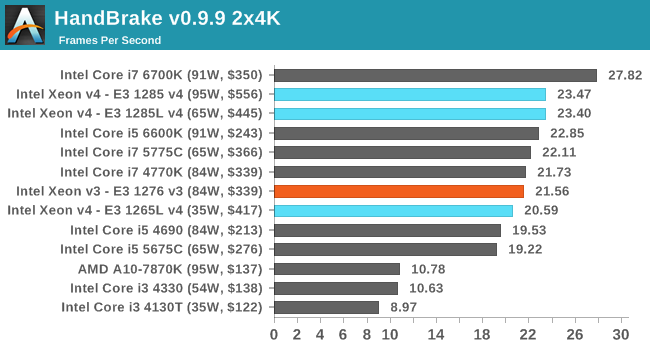
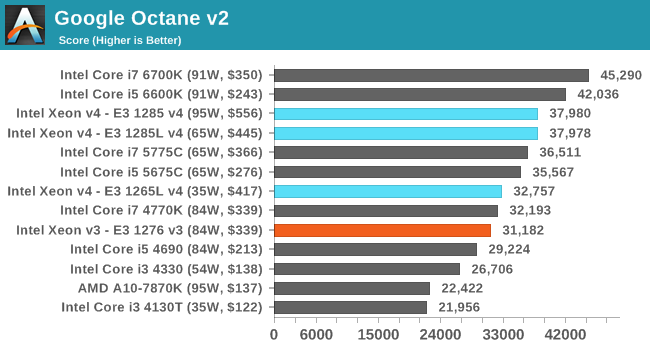
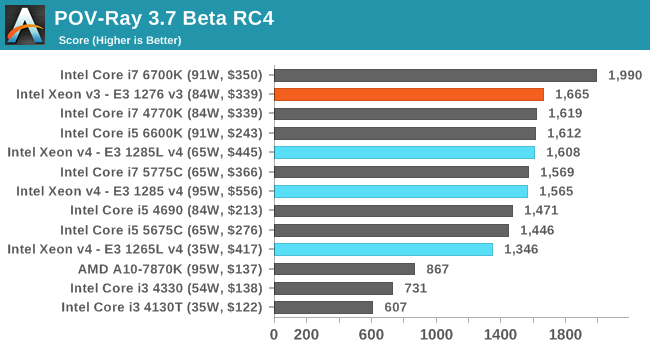
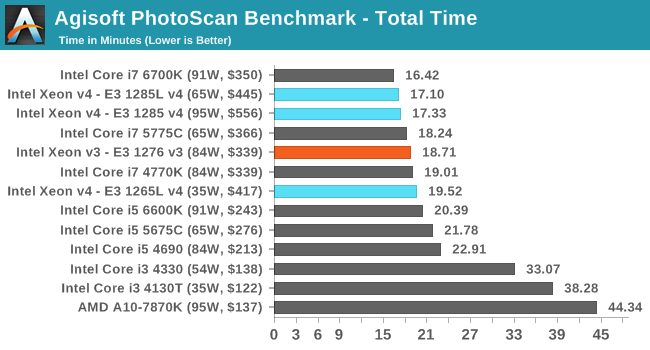
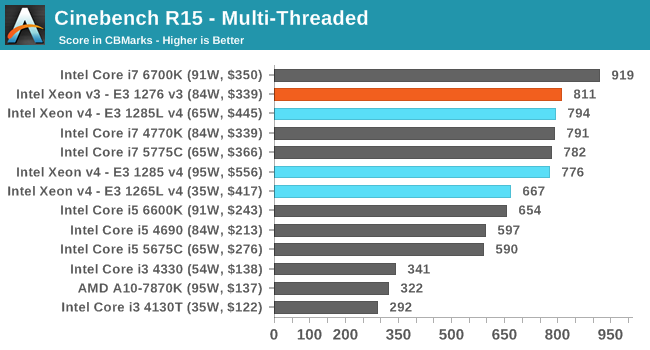
We said at the start of this review that one of the key parts to examine was the main parallel to the 95W of the E3-1285 v4 and the E3-1276 v3 at 84W due to their near similar (but not ideal) thermal design power metrics. The differentiator here is that the E3 v3 has some extra frequency, but the E3 v4 range has eDRAM.
At least, we thought this should be the battle to be had, but it is clear from the results that something else is more interesting. Comparing the E3-1285 v4 at 95W to its lower power variant, the E3-1285L v4 at 65W, we see that the low power variant scores better on almost all benchmarks.
The only difference between these two processors aside from the 30W of TDP should be the 100 MHz gap in favor of the 95W part. We said at the beginning that this 100 MHz does not adequately explain 30W in the grand scheme of things, so the lower powered model must also have a substantially better voltage/frequency profile. This, as it happens, has some knock on side effects.
In a couple of CPU tests, the extra frequency wins. This boils down to only 3DPM and Sunspider, both tests that arguably are neither extensively pressing the processor nor exhaustive in their capabilities. But the lower power model, by virtue of the better binning, is able to keep its higher frequency turbo mode available for 100% of the time in our testing, ultimately giving a higher frequency and completing work quicker. This is despite the base frequency of the E3-1285 v4 being higher, and alluding to a variable turbo frequency profile based on power draw. To cap it off, the E3-1285L v4 is also $111 cheaper. So when the two processors are put side-by-side, the decision is obvious. We would choose the E3-1285L v4 every time.
This means the title fight should be between the 65W E3-1285L v4 and the E3-1276 v3 at 84W. Here it gets a little more edgy – the v4 here is technically 100 MHz above the i7-5775C which we looked at in our last Broadwell review, and we get more into a performance/power based efficiency discussion based on the TDP difference than the 95W vs 84W discussion.
In DRAM heavy scenarios such as WinRAR, which requires a large amount of cache to retain dictionary compression tables, the benefits of the eDRAM are easy to see. Benchmarks on the integrated graphics also win out due to the Iris Pro P6300. For discrete graphics, the Broadwell parts certain win over the v3 for efficiency at this point, with results between the two being almost identical. But the big one to note here is Photoscan in pure CPU mode, where Broadwell takes a minor lead – Photoscan uses a set of fifty two-dimensional photos with no depth information to create a three-dimensional imagine over several stages, so managing that data around the memory subsystem becomes a handful when there are 40,000 data points per picture in flight. This benchmark was suggested to us by an archivist at a national library who uses it to recreate models of the artifacts in their storage for external examination.
For all the other CPU tests, a dichotomy appears. The higher frequency v3 wins for compute driven performance, but data driven metrics (and efficiency) are the realm of Broadwell, Xeon or otherwise, as long as there is frequency to match.
As mentioned on the first page of the review, on the suggestion of a number of our readers and based on these interesting, we are looking into other avenues which are also data driven. Previously our Chrome compilation benchmark was a featured set piece in our testing, but has fallen away and a similar equivalent needs to be reintroduced. As a result, we are speaking to some users and looking into a series of tests of this nature that afford a repeatable and consistent point of analysis – ideally in an automated context if possible and encompassing a variety of projects and languages. At current there is no time framework for introduction, but September affords some time to focus on the project and then test a number of processors on it. Thoughts and suggestions should be forwarded to ian@anandtech.com.


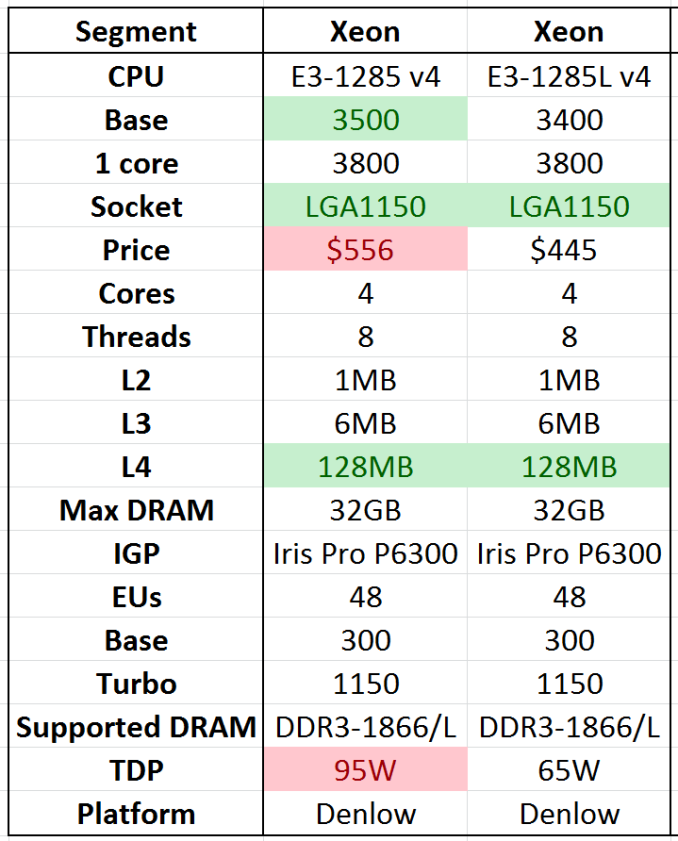
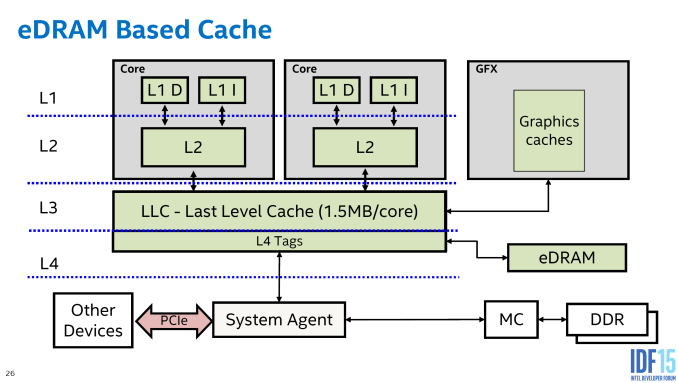








72 Comments
View All Comments
Ian Cutress - Thursday, August 27, 2015 - link
So to clear up your misconceptions: we (or more specifically, I) have not retested any AM3 product yet on our 2015 benchmark suite due to time restrictions and general lack of reader interest in AM3. I have 3 test beds, and our CPU/GPU tests are only partially automated, requiring 35+ working hours of active monitoring for results. (Yes, can leave some tests on overnight, but not that many). Reserving one test bed for a month a year for AM3+ limits the ability to do other things, such as motherboard tests/DRAM reviews/DX12 testing and so on.You'll notice our FX-9590 review occurred many, many months after it was officially 'released', due to consumer availability. And that was just over 12 months ago - I have not been in a position to retest AM3 since then. However, had AMD launched a new CPU for it, then I would have specifically made time to circle back around - for example I currently have the A8-7670K in to test, so chances are I'll rerun the FM2+ socket as much as possible in September.
That being said, we discussed with AMD about DirectX 12 testing recently. Specifically when more (full/non-beta) titles are launched to the public, and we update our game tests (on CPU reviews) for 2016. You will most likely see the FX range of CPUs being updated in our database at that time. Between now and then, we have some overlap between the FX processors and these E3 processors in our benchmarking database. This is free for anyone to access at any time as and when we test these products. Note that there is a large price difference, a large TDP difference, but there are some minor result comparisons for you. Here's a link for the lazy:
http://anandtech.com/bench/product/1289?vs=1538
The FX-9590 beats the 35W v4 Xeon in CineBench, POV-Ray and Hybrid, despite being 1/3 the price but 6x the power consumption.
Oxford Guy - Thursday, August 27, 2015 - link
The 9590 is a specialty product, hardly what I was focusing on which is FX overclocked to a reasonable level of power consumption. The 9590 does not fall into that category.You can get an 8320E for around $100 at Microcenter and pair it with a discount 970 motherboard like I did ($25 with the bundle pricing a few months ago for the UD3P 2.0) and get a decent clockspeed out of it for now much money. I got my Zalman cooler for $20 via slickdeals and then got two 140mm fans for it. The system runs comfortably at 4.5 GHz (4.4 - 4.5 are considered the standard for FX -- for the point where performance per watt is still reasonable). Those pairing it with an EVO cooler might want 4.3 GHz or so.
The 9590 requires an expensive motherboard, expensive (or loud) case cooling, and an expensive heatsink. Running an FX at a clockspeed that is below the threshold at which the chip begins to become a power hog is generally much more advisable. And, review sites that aren't careful will run into throttling from VRMs or heat around the chip which will give a false picture of the performance. People in one forum said adamantly that the 9590 chips tend to be leaky so their power consumption is even higher than a low-leakage chip like 8370E.
One of your reviews (Broadwell I think) had like 8 APUs in it and not a single FX. That gives people the impression that APUs are the strongest competition AMD has. Since that's not true it gives people the impression that this site is trying to manipulate readers into thinking Intel is more superior than it actually is in terms of price-performance.
There is no doubt that FX is old and was not ideal for typical desktop workloads when it came out. Even today it only has about 1.2 billion transistors and still has 32nm power consumption. But, since games are finally beginning to use more than two cores or so, and because programs like Blender (which you probably should use in your results) can leverage those cores without exaggerating the importance of FPU (as Cinebench is said to do) it seems to still be clinging to relevance. As for lack of reader interest in FX, it's hard to gauge that when your articles don't include results from even one FX chip.
Regardless of reader interest if you're going to include AMD at all, which you should, you should use their best-performing chip (although not the power-nuts 9590) design — not APUs — unless you're specifically targeting small form factors or integrated graphics comparisons.
Oxford Guy - Thursday, August 27, 2015 - link
You also ran an article about the 8320E. Why not use that 8320E, overclocked to reasonably level like 4.5 GHz, as the basis for benchmarks you can include in reviews?SuperVeloce - Thursday, August 27, 2015 - link
Clocks are not identical (you know the meaning of that word, right?). And the 4790k was released a year after first haswells. Usually you compare models from the launch day of the said arhitecture.MrSpadge - Thursday, August 27, 2015 - link
It doesn't matter what launched on launch day of the older competition. It matters what one can buy at the current launch date instead of the new product.mapesdhs - Thursday, August 27, 2015 - link
Hear hear! Reminds me of the way reference GPUs keep being used in gfx articles, even when anyone with half a clue would buy an oc'd card either because they're cheaper, or seller sites don't sell reference cards anymore anyway.Oxford Guy - Wednesday, August 26, 2015 - link
"cue the realists"Corporations are a conspiracy to make profit for shareholders, CEOs, etc. The assumption of conspiracy should be a given, not a "theory". Any business that isn't constantly conspiring to deliver the least product for the most return is going to either die or stagnate.
boxof - Wednesday, August 26, 2015 - link
"In a recent external podcast, David Kanter"Couldn't bring yourselves to mention your competition huh? Stay classy.
Dr.Neale - Wednesday, August 26, 2015 - link
Your comparison of the Xeon e3-1276 v3 to the e3-1285 v4, e3-1285L v4, and e3-1265L v4 is systematically slightly biased in favor of the e3-1276 v3, because for all tests you use (non-ECC) DDR3 1866 memory, whereas with ECC memory (and a C226 chipset that supports it, as in an ASUS P9D WS motherboard), the v3 Xeon is limited to DDR3 1600, while the v4 Xeons can use DDR3 1866 memory.Therefore using DDR3 1866 memory with the v3 Xeon gives it a slight systematic performance boost over what it would achieve with only DDR3 1600 memory, which is the maximum speed it can use in an ECC / C226 workstation.
With this in mind, I believe the performance of a e3-1276 v3 Xeon with DDR3 1600 memory would more closely match that of the e3-1285 v4 and e3-1285L Xeons with DDR3 1866 memory, than is indicated in the graphs here, where the v3 and v4 Xeons are all tested with the same DDR3 1866 memory only.
ruthan - Thursday, August 27, 2015 - link
This power consumption mystery have to be discovered, its like Geforce 970 4 GB thing. Maybe Intel cheating with those numbers, because there are customer like me, which prefer lower power and silence are ready to pay for that.Most typical workstation use case, where im still missing tons of horsepower on CPU side is virtualization, especialy for gaming, yesterday released Vmware workstation 12 with DX10 support. Especially in Linux enviroment, gaming in virtual machine make a sense (i know, i know there is not DX10 suportt even through wrapper).